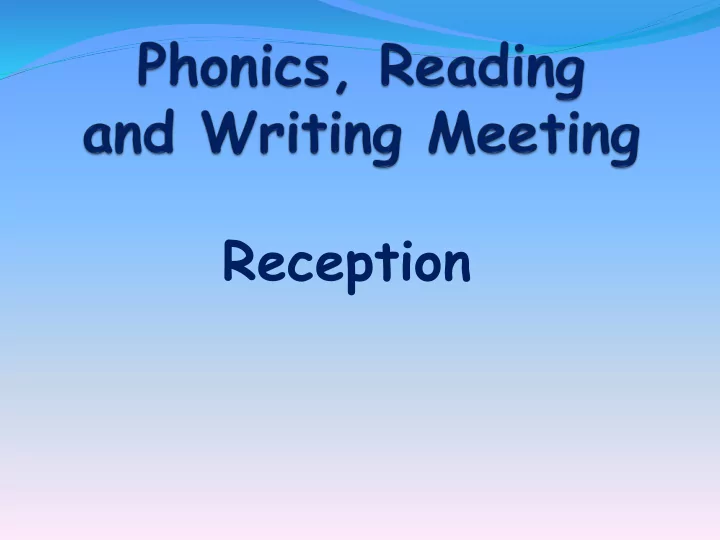

Reception
Meeting contents: Speaking and listening Nursery Fine motor skills Mark making Letters and sounds. Reception Reading Phonics Writing Things you can do at home to help your child
Speaking and listening A child that is not at expected standard in language development at age 5 years is 11 times less likely to achieve the expected level in Maths at age 11. Education Policy Institute Early Years Intervention Foundation
Reading – Phonics Letters and Sounds What is Phonics? “Words are made up from small units of sound called phonemes. Phonics teaches children to be able to listen carefully and identify the phonemes that make up each word. This helps children to learn to read words and to spell words.” Phonics play
“… written language is basically a kind of a code. Teaching phonics is just teaching children to crack that code.”
What is taught in Phonics? Three main things are taught in phonics: GPC (Grapheme Phoneme Correspondence - Knowing the sounds) Segmenting Blending
Now it’s your turn s a t p i n m d g o c k e u r h b f l j v w x y z qu ch sh th ng ai ee igh oa oo ar or ur ow oi ear air
Now let’s try blending got cat big with went Nonsense words mip fop Tricky words I to no the The Alphabet is still important!
Reception Reading at School We are currently learning how to read and write individual sounds. Majority of children are just beginning to blend simple words using the sounds we have already learnt.
Reading Books It is important that you continue to read books with your children at home so they have plenty of opportunity to experience a range of books. We change reading books once a week
How to Use the Reading Books We want to develop children’s confidence as a ‘reader.’ Children decode words by sounding out, recognising the shape of the word and considering the context and illustrations. If your child doesn’t feel confident enough to read independently try reading the book to them and sounding out simple words for them to blend. It is important that your children understand what they are reading. Discussions and questions after every few pages will ensure that they are reading for meaning.
Things You Can do at Home Practise reading the high frequency words in the handout given to you. Make it fun. Your child has been bringing home sounds sheets. Practise the sounds. Please keep us up to date with your child’s reading at home by writing a quick note in their reading records. Book bags make it easier.
Practise writing Around the dinosaur’s letters using the bottom, up his tall letter formation neck and down to his sayings included in feet. your handout. It is important children form these letters correctly for when they come to join their letters later on. Please make sure children only use capital letters where needed.
http://www.letters-and-sounds.com/ http://www.familylearning.org.uk/phonics_games.html www.teachfind.com/national strategies - articulation of phonemes.
Recommend
More recommend